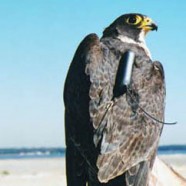
Abstract
Fundación Ara and Earthspan conducted a study of peregrine falcons (Falco peregrinus) wintering on the Gulf coast of Mexico. Data collection occurred between January 1997 and October 1998. The main aim of the study was to better understand the movements of peregrine falcons on their wintering grounds. Other objectives were to track peregrines to their breeding areas and back to the wintering grounds. Earthspan provided Geographical Information Systems (GIS) training and support.
Ten (7 adult females, 2 second year females, and 1 adult male) peregrine falcons were caught on the Gulf Coast of Mexico in January 1997, 23 (16 adult females, 6 second year females and 1 male) in February 1998. Twelve individual falcons were fitted with satellite received transmitters (PTTs). Six female falcons were fitted with PTTs in 1997 and 8 (7 females and 1 male) were fitted in 1998. Two of the falcons that were fitted with PTTs in 1997 were recaptured and fitted with PTTs in 1998. The movements of these birds were monitored. The movements of 14 peregrines were recorded throughout the wintering period. Using data from both years, median areas for minimum convex polygons at 50% and 90% levels were 1173 and 8311 ha., respectively.
On average birds left wintering ground in the first week of May. Departure dates were similar in both years. Thirteen birds were followed through the spring migration period. One bird that was tagged in both years showed fidelity to its summer (breeding) grounds. Birds summered across northern Canada from Franklin River in the west and to the western coast of Greenland in the east.
PTT data and capture locations of birds caught in more than one year indicate that peregrines use the same area of beach for wintering year after year, and the wintering ranges of those birds tracked in more than one year showed a high degree of overlap.
An area of apparent high density of wintering peregrines was identified near Matamoros.
In 1998, two aerial and one ground-based shorebird counts were made in the lower Laguna Madre. Aerial counts were made in February and April and were of 8,981 and 7,345 individuals, respectively. These were primarily ‘small shorebirds’ that could not be identified to the species level. Ground-based counts were of 14,043 individuals, primarily western and least sandpipers.
Many dead sea turtles were seen on the beach during the survey.
Earthspan provided set-up and training in Geographical Information Systems (GIS) and database management. The aim was to provide Ara with an ability to display and undertake preliminary analyses.

- Peregrine falcon
Introduction
A feature of peregrine falcons in many parts of the world is their migratory behavior. Some spend more time in the wintering areas than they do on the breeding grounds. Many that winter along the coast of the Gulf of Mexico breed in arctic regions of North America and Greenland. Contaminants such as organchlorines and polychlorinated biphenyls (PCB’s), can concentrate in peregrine falcons. Along with other products primarily associated with agricultural applications, these contaminants caused population declines in peregrines and a variety of other species through direct mortality and decreased productivity due to eggshell thinning. While the use of the most persistent and lethal organochlorine pesticides has decreased or been curtailed (particularly in developed countries), and tundra peregrine populations have responded favorably, toxins are still present in the environment and found in most peregrines sampled along the coast of the Gulf of Mexico (Henny, et al., 1996). Because the breeding areas generally do not suffer from pollution associated with agriculture, it is likely that the falcons are contaminated primarily either on migration or on their wintering areas. For these reasons, it is as important to understand their ecology while wintering as during the breeding and migration periods. In the case of the study area, there has been the recurring threat that an intracoastal waterway might be built between Brownsville and Tampico.
We present data from peregrine falcons fitted with satellite-based telemetry technology. The data record the movement of the birds during much of their wintering time in 1996/97 and 1997/98. They also detail the timing of migration, and the migratory path for some birds. Data suggest likely breeding areas of these birds. This document summarizes the work on peregrine falcons, and consolidates information from monthly and quarterly reports, Nov 1996-July 1998.
Study Area, Materials, and Methods
Survey, capture, instrumentation and monitoring of falcons
Our study occurred on the Mexican Gulf coast between 23o00’and 24o00’ N latitudes in the state of Tamaulipas, centered on the towns of La Pesca and Tepejuahe. Some capture and survey effort was put into the beach area near Matamoros. This area was chosen for the relative ease of access to the beach and location in an area where an Intracoastal Waterway is being proposed.
The portion of coast within the study area is characterized barrier islands that separate the Laguna Madre from the

- Peregrine falcon study
Gulf of Mexico vary in width from about 100 m up to 2-km. At high tide, the sandy beach is about 5-20 m in width. The western side of the islands are covered in vegetation including grasses (e.g. seacoast bluestem, Schizachyrium scoparium littoralis) and small shrubs (e.g partridge pea, Cassia fasiculata). The Laguna Madre is cut in a N-S direction by a channel, which remains filled with water throughout the year. The mud flats on either side of the channel are sometimes dry, but are sometimes covered by shallow water. Weather conditions play a role in the extent to which the mud flats are flooded. Local people indicate that the laguna is flooded mostly in the winter. The mainland in our study area has been largely converted to ranch use. Forests that exist are either small relicts of the original vegetation or are secondary growth.
Falcons were trapped using noose-harnessed pigeons under permits issued to Fundación Ara by the Mexican government. T. Maechtle provided USFWS bands listed under his permit. Measurements were taken for all captured birds. Capture locations were recorded using a hand-held GPS reciever. Once trapped, peregrines were hooded, aged, sexed and measured. In 1997 blood was drawn for future contaminant and DNA testing; samples in 1998 were for DNA testing only. All blood samples were archived with Fundación Ara. Some falcons were fitted with satellite-received transmitters (PTT’s), banded and released. Duty cycles for the 30 gram PTTs (for females) were set at 10 hrs on, 22 hrs off for 23 cycles, then 10 hrs on 46 hrs off for 26 cycles, then 10 hrs on 166 hrs off for 38 cycles, then shut down. This schedule allowed for the collection of as much data as possible on the wintering grounds, and the power to follow the migration (north and south) and identify summering areas. The 20-gram tags (for males) were set to maximize wintering-ground data collection, and were to run for a total of 500 hrs. In the days immediately following capture, many falcons were re-sighted, and transmitters appeared to be well tolerated.
Data on falcon locations were collected by the ARGOS system. Data were downloaded by Earthspan and sent ot Fundación Ara at least once per week. Location estimates collected by ARGOS are categorized according to likely accuracy (Z,B,A, 0,1,2,3 in ascending order of accuracy). Location classes 1, 2 and 3 mean that 68% of location estimates would lie within a radius of 1 km, 350 m and 150m respectively. We used only location classes 1-3 for our analyses.
Location estimates were displayed within the ArcView GIS (ESRI, Redlands, Ca.) environment, and analyses of the areas covered by the falcons was done using RANGES V (ITE, Dorset, U.K.) software. We described areas used by peregrines during the winter by minimum polygon area analysis.
Shorebird surveys
In 1997, a pilot study of prey assessments using point counts of the laguna and transects along the beach revealed that these methods would not be useful in counting shorebirds in the study area. In 1998, two surveys were conducted by aircraft, and was supplemented by a ground-based count. The same team that performed aerial surveys conducted the ground survey. A more detailed description of shorebird survey methods used in 1998 can be found in quarterly reports of April and July 1998.
Results
Survey and capture of falcons
From 11-24 January 1997 and 17 February – 11 March 1998 fieldwork aimed at the capture and fitting of PTTs to wintering peregrine falcons was undertaken. Surveys were conducted along the beach connecting Matamoros, La Pesca, Tepejuahe, and Tampico. Locations of falcons sighted by the falcon capture team and by the shorebird survey team while conducting ground based shorebird counts are summarized in Appendix 1, Tables 1 and 2. Locations are mapped in Appendix 2 Map 1. A maximum of 17 falcons were seen but not captured in 1997. In 1998 a maximum of 31 were seen and not captured. The shorebird survey team observed a maximum of 15 peregrine falcons in the winter of 1997/98.
Over the two years of the study 33 peregrine falcons were captured, only two were males. Table 2 summarizes these captures; Appendix 2, Map 1 maps the capture locations. This sex bias in capture was indicative of the ratio of male and female falcons seen on the beach. Throughout the period of fieldwork, only 4-5 male peregrine falcons sere seenIn 1997, ten adult peregrine falcons were captured (1 male and 9 females). In 1998, 22 wintering peregrines (1 male and 21 females) were captured, and one was recaptured.
Fourteen PTTs were fitted to peregrines, (6 females in 1997, and 1 male and 7 females in 1998). Three falcons captured in 1998 had been caught in previous years (two were tagged with PTTs in 1997, and one had been caught in 1996). All three of these were fitted with PTTs in 1998. Appendix 2, Map 1 shows the location of peregrine sighted and captured. Locations of capture for birds trapped in both years of the study were found close to one another.
Wintering areas – location, size, and composition
Appendix 2, Maps 2 and 3 show the scatter of location estimates received for peregrine falcons marked in 1997 and 1998, respectively. Appendix 2, Maps 4 and 5 show the convex polygons that describe the ranging of wintering peregrines at the 90% and 50% levels in 1997 and 1998, respectively. Table 3 shows the areas covered by these polygons. Most peregrines stayed throughout the winter period on the stretch of beach where they were captured. Some birds (14505, 12845, 12850, and 12851) did shift their movement patterns so that more than one area of activity concentration were evident (See Maps 2 and 3.). In most cases these movements were along a north-south axis and represent no change in the general habitat used by the peregrines (i.e. beach and laguna). Falcon 12850 did move from the beach where it was captured to an area along a creek.
When the ranges of birds that shifted their areas of activity concentration were removed, the size of the ranges in 1997 were larger than those in 1998 at both the 50% (P= 0.003, F test) and 90% level ( P= 0.005, F-test). For both birds that were marked in both years ranges at the 50% and 90% level were larger in 1997 than in 1998 (Table 4). Appendix 2, Map 5 shows the location estimates of peregrines that were tagged in both years.
